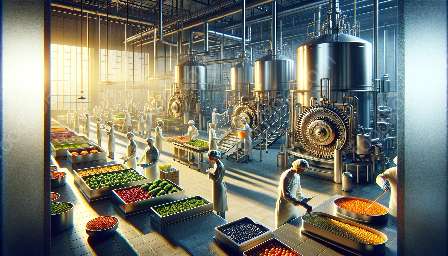Food chemistry delves into the intricate molecular compositions of the ingredients we use to create delicious dishes, exploring how these components interact and transform during food processing and cooking. This topic cluster will cover the fundamental principles of food chemistry, its relationship with food processing, and its relevance to culinology, shedding light on the ways in which chemistry shapes the tastes, textures, and nutritional value of the foods we enjoy.
The Basics of Food Chemistry
Food chemistry is the study of the chemical processes and interactions that occur during the creation, handling, and storage of food. At its core, food chemistry examines the composition of food components such as proteins, carbohydrates, lipids, vitamins, minerals, and water. Understanding the molecular structure and behavior of these components is essential for developing an in-depth comprehension of the transformations that take place in food during various stages of processing and cooking.
Molecular Structure and Function
The molecular structure of food compounds plays a crucial role in determining the physical and chemical properties of food. Proteins are made up of amino acids linked together by peptide bonds, and their specific arrangement dictates their functionality in various culinary applications. Carbohydrates, such as sugars and starches, contribute to the taste, texture, and appearance of foods. Lipids, including fats and oils, are responsible for mouthfeel, flavor delivery, and overall palatability. Exploring the molecular structure of these compounds provides insights into how they contribute to the sensory experience and nutritional content of food.
Chemical Reactions in Food Processing
Chemical reactions are fundamental to food processing, as they impact the quality, safety, and shelf life of food products. For example, the Maillard reaction, which occurs between amino acids and reducing sugars when exposed to heat, leads to the formation of desirable flavors and aromas in cooked foods. Understanding these chemical reactions allows food scientists and chefs to optimize processing methods to achieve the desired sensory attributes and nutritional outcomes.
Food Preservation and Shelf Life
Food chemistry is integral to the development of preservation techniques that extend the shelf life of perishable foods. By harnessing the principles of chemistry, researchers and food technologists can create barriers to microbial growth, inhibit enzymatic activity, and prevent oxidative deterioration. These preservation methods, such as pasteurization, canning, dehydration, and fermentation, are essential for maintaining food safety and ensuring food availability throughout the year.
Impact on Flavor and Aroma
Chemical compounds present in foods contribute to their characteristic flavors and aromas. Volatile organic compounds, responsible for the aromas of fruits and spices, undergo chemical changes during cooking and processing, leading to the development of complex flavor profiles. Understanding the chemistry behind flavor formation enables chefs and food scientists to manipulate these compounds to create unique taste experiences and innovative culinary creations.
Culinology: Integrating Food Chemistry and Culinary Arts
Culinology, a fusion of culinary arts and food science, relies heavily on food chemistry to drive innovation in the food industry. Culinologists leverage their knowledge of food chemistry to develop new products, enhance flavors, and improve the nutritional quality of foods. By understanding the behavior of food components at a molecular level, culinologists can optimize recipes, streamline production processes, and create tantalizing dining experiences that captivate and delight consumers.
Enhancing Nutritional Value
Food chemistry plays a vital role in fortifying foods with essential nutrients to address nutritional deficiencies and improve public health. By understanding the interactions between nutrients and other food components, culinologists can employ fortification techniques to enhance the nutritional value of staple foods, enriching them with vitamins, minerals, and bioactive compounds that contribute to overall well-being.
The Future of Food Chemistry and Culinology
As our understanding of food chemistry continues to evolve, so too will the techniques and technologies used in food processing and culinology. Advances in analytical chemistry, molecular gastronomy, and sustainable food production are poised to revolutionize the ways in which we perceive, produce, and consume food. With a deeper appreciation for the intersection of food chemistry, food processing, and culinology, we can embark on a journey of culinary exploration, uncovering the hidden potential of ingredients and unlocking new dimensions of flavor, nutrition, and sustainability.


